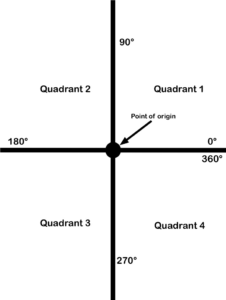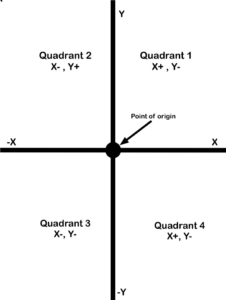Vectors
Quadrants
Like a Star Trek quadrant?
First off: Nerd alert!
Secondly, yes, a quadrant is a circle cut into four parts.
What does this have to do with electricity?
Voltage and currents are constantly changing magnitude and direction. When changing direction, they actually rotate in a counterclockwise direction. They are tethered to a point of origin.

Each quadrant contains certain directions.
- Quadrant 1 has 0 to 90 degrees.
- Quadrant 2 has 90 to 180 degrees.
- Quadrant 3 has 180 to 270 degrees.
- Quadrant 4 has 270 to 360 degrees.
This is very important as it helps us to determine which vectors belong in which quadrant.
Polarity
It is also important to understand polarity when dealing with quadrants. A quadrant system is basically an X-Y graph. We use the point of origin as a reference point. On the X axis, anything to the right of the point of origin is positive and anything to the left is negative. On the Y axis, anything above the point of origin is positive and anything underneath it is negative. This means each quadrant has its own polarity, as shown in Figure 30.

This too is extremely important when it comes to adding vectors.
Are you getting excited yet? This is all going to come together in one magical dance.
Video!
This video goes into greater detail about the specifics of all four quadrants.
Attributions
Quadrants and vectors. video by The Electric Academy is under a Creative Commons Attribution Licence.

